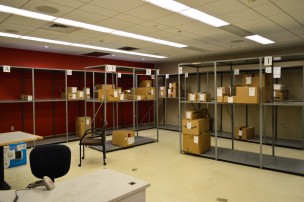Behind the scenes, the package room can be a stressful, but entertaining place to work.
Imagine receiving over 1,000 emails in a day. It would take a considerable amount of time just to open each one of them, let alone actually read them. On top of clicking open all of the emails, imagine having to enter a set of unique codes for each and then having to arrange them in alphabetical order. And, in case this does not sound stressful enough, all this work must be done within a seven-hour workday.
This scenario paints a simplified picture of what the Wesleyan package room, known as WesStation, does on a daily basis, and it in no way comes close to describing the amount of work demanded of the WesStation staff. Generally, the package room fades into the background for most students. Yet, while it occupies little of our attention, we all have at one point or another demanded a lot of effort from the WesStation staff with the packages we order online and receive from family members.
“People don’t realize it when they are at the window, when they are in line, and they are getting huffy and puffy, and we are like, ‘Listen, I’m only one person,” said Danielle Salafia, a part-time employee at WesStation. “I’m sorry. I’m trying to wait on you, I’m trying to ring you up, I’m trying to sort mail, and it’s only me. It becomes really chaotic.”
Staffed with three full-time, one part-time, and a few student employees, WesStation faces hundreds of packages each day in a room smaller than the size of two classrooms combined. These packages, generally sent through UPS and FedEx, arrive in big, white, plastic bags and are rolled into the station on metal carts the size of an average person’s body length. As I first entered the package room, my path was nearly blocked by one of these carts with about 15 bags sitting on top of it. Holly Nicola, WesStation’s head manager, informed me that this cart represented only a small portion of those from FedEx that day.
Unlike handling emails, processing packages requires more than simply clicking a button on the computer. The process begins with punching in the box number and where the box is located, then scanning the tracking number. After a record is made in the computer, staff members label each package and sort them in shelves in alphabetical order. Meanwhile, the WesStation staff helps students at the window and runs the mailroom to deposit smaller packages in mailboxes, of which there are over 3,000.
“Every single package has to be touched. We have to physically clock in every single package,” Salafia said.
Given this complex process, it is hard to believe that the WesStation staff successfully processed more than 1,000 packages in seven hours all during one day in early September this year. That is an average of processing one package every two minutes per employee nonstop for seven hours.
Despite the staff’s assiduous effort and dedication, the WesStation still faces challenges and limitations.
“The biggest challenge we have is having enough staff, enough space, enough room,” Salafia said.
The employees said that due to limited funding and work space, processing large quantities of packages is hectic and high-pressured each day. Salafia said that WesStation used to be located on the first floor of Usdan and was combined with the mailroom. Although she was not yet working at Wesleyan back then, she feels that the old way would have made the process much more convenient for the staff and the students. The staff would not have to run between floors to distribute packages, and students would not need to travel as far for their packages. While this proposal is not yet a reality, the WesStation staff remains hopeful about talks regarding the change.
Despite the difficulties, however, each WesStation employee holds a strong passion for the job. Talking about the best part of the job, Nicola said, without any hesitation, that the students make everything worthwhile.
“You know, you talk to them, and you know when to joke and when not to joke,” Nicola said. “Because [during] tests and finals [weeks] like that, you don’t joke with students. You give them the packages [and be like,] ‘Okay, have a nice day.’ You know. We have some really fun students coming down to get their packages, and they make things easier for [us].”
In addition to entertaining exchanges with students, humorous accidents are also bound to happen. From exploded acne powder to ringing phones in packages to packages meant for Westfield, Salafia and Nicola shared stories with me about the strange things, rare but memorable, that they’ve seen while working here. They are especially frustrated, Nicola said, when the packages simply say “College” in the recipient’s section or when parents write their own names instead of the student’s as the recipient. In these cases, they have to take additional effort to track down students or confirm tracking numbers.
“If you say you don’t have a tracking number, I can’t give it to you, because it’s for ‘College,’” Nicola said. “I’m still waiting for ‘College’ to come and pick up this package.”
So, a word of advice: If you are not named College or thankfully don’t have the same name as your parents, ask your parents to put your own name on the package label. Of course, that is unless you just want an excuse to come down and share more quality time with the WesStation staff, which is never a bad idea.
